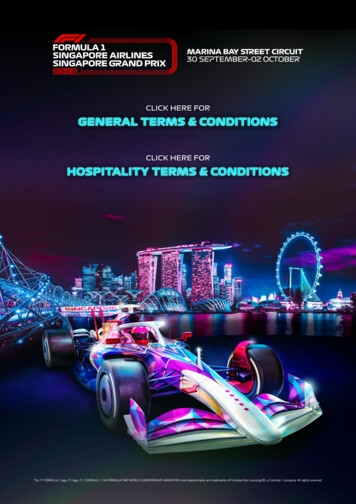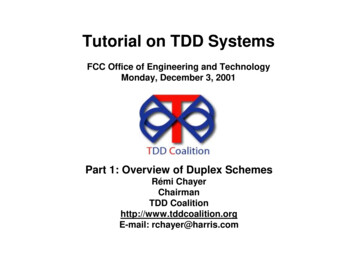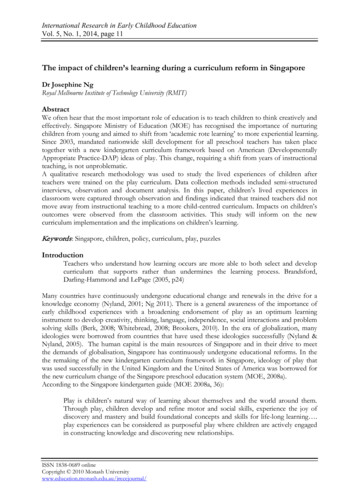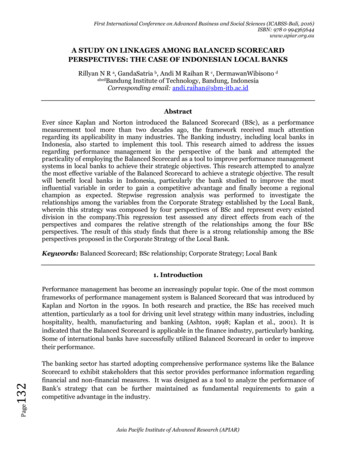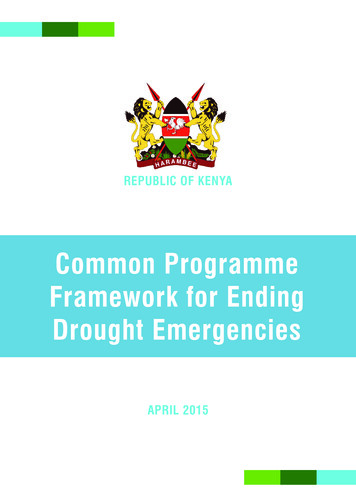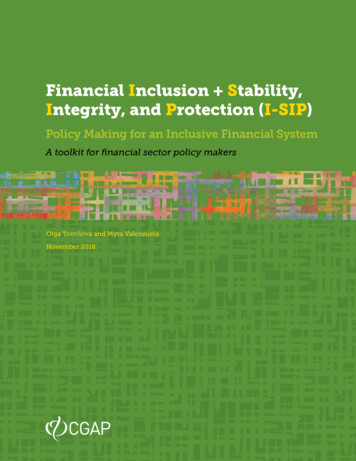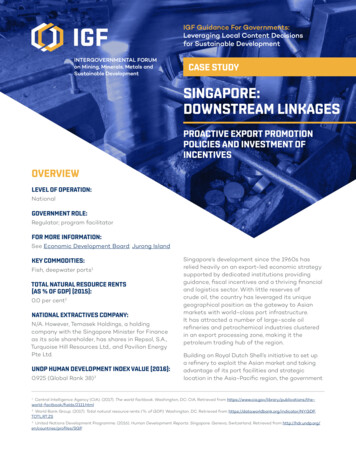
Transcription
IGF Guidance For Governments:Leveraging Local Content Decisionsfor Sustainable DevelopmentCASE STUDYSINGAPORE:DOWNSTREAM LINKAGESPROACTIVE EXPORT PROMOTIONPOLICIES AND INVESTMENT OFINCENTIVESOVERVIEWLEVEL OF OPERATION:NationalGOVERNMENT ROLE:Regulator; program facilitatorFOR MORE INFORMATION:See Economic Development Board; Jurong IslandKEY COMMODITIES:Fish, deepwater ports1TOTAL NATURAL RESOURCE RENTS(AS % OF GDP) (2015):0.0 per cent2NATIONAL EXTRACTIVES COMPANY:N/A. However, Temasek Holdings, a holdingcompany with the Singapore Minister for Financeas its sole shareholder, has shares in Repsol, S.A.,Turquoise Hill Resources Ltd., and Pavilion EnergyPte Ltd.UNDP HUMAN DEVELOPMENT INDEX VALUE (2016):0.925 (Global Rank 38)3Singapore’s development since the 1960s hasrelied heavily on an export-led economic strategysupported by dedicated institutions providingguidance, fiscal incentives and a thriving financialand logistics sector. With little reserves ofcrude oil, the country has leveraged its uniquegeographical position as the gateway to Asianmarkets with world-class port infrastructure.It has attracted a number of large-scale oilrefineries and petrochemical industries clusteredin an export processing zone, making it thepetroleum trading hub of the region.Building on Royal Dutch Shell’s initiative to set upa refinery to exploit the Asian market and takingadvantage of its port facilities and strategiclocation in the Asia-Pacific region, the government1Central Intelligence Agency (CIA). (2017). The world factbook. Washington, DC: CIA. Retrieved from factbook/fields/2111.html2World Bank Group. (2017). Total natural resource rents (% of GDP). Washington, DC. Retrieved from T.ZS3United Nations Development Programme. (2016). Human Development Reports: Singapore. Geneva, Switzerland. Retrieved from http://hdr.undp.org/en/countries/profiles/SGP
2implemented an export-driven industrial policycentred around refined oil products. The successover the years has been sustained thanks to thestrong fuel consumption trends in rapidly growingAsian economies. Recognizing a shift in theregion’s product demand trends, the governmenthas moved further downstream by developing thepetrochemicals sector.To implement its vision, thegovernment has adopted atwin-track industrial strategyof keeping bureaucraticregulations to a minimum whilebuilding supportive dedicatedinstitutions to attract, stewardand support investments. Thiswas coupled with generousfiscal and financial incentives.The industrial strategy alsoleveraged the power ofindustrial agglomerationwith the Jurong Island Export Processing Zone(EPZ), which has attracted companies along thevalue chain, including in refining, storage andshipping. A thriving financial and service sectorsupports these activities. The model has allowedthe industry in Singapore to differentiate itselffrom other emerging players in Asia by helpingfirms achieve operational efficiencies and costreductions. Over time, oil trading has become amajor sector in the country, granting Singapore itsprimacy as Asia’s oil trading hub.After independence from the British regime, in1961 Singapore established a dedicated institutionto promote industrial development and attractinvestment. The so-called Economic DevelopmentBoard (EDB) was endowed with a budget of USD100 million to design and implement policiesto promote industrial investments in Singapore,The government has adopted a twintrack industrial strategy of keepingbureaucratic regulations to a minimumwhile building supportive dedicatedinstitutions to attract investments.THE PILLARS OF A SUCCESSFULDOWNSTREAM POLICYSingapore’s success in attracting the downstreamvalue chain of oil has its roots in the late 19thcentury, when the British Empire built three bulkstorage tanks for kerosene on Bukom Island(belonging to the Singapore archipelago) forstoring oil and supplying British operations inEast Asia. They also invested in Singapore’s portinfrastructure and regional connectivity.foster enterprise opportunities in internationalmarkets and offer development financing options.The 1965 separation from the Federation ofMalaysia, which for its part was pursuing importsubstitution strategies, empowered the EDB. Itbecame the engine of Singapore’s economicgrowth through an export-oriented industrialstrategy. At the core of this strategy was thedesire to build on the strategic comparativeadvantage in the oil industry built by the BritishEmpire and to leverage Singapore’s strategic portbetween the Indian Ocean and the Pacific Ocean.In this context, the 1960s and 1970s saw theestablishment of further supportive institutionsto the oil-based export industry as well as thedeployment of a fiscal incentive policy: In 1968, the EDB created the DevelopmentBank of Singapore (DBS) to oversee capitalfinancing for export-oriented industries(EOI), and the International Trading Company(Intraco) with the mission “to developoverseas markets for Singapore-madeproducts and to source cheaper raw materialsfor local industries through bulk buying.”44Rodan, G. (1989). The political economy of Singapore’s industrialization: National state and international capital. International Political EconomySeries. Palgrave Macmillan UK.
3 Investment incentives included allowingcompanies to operate tax-free for the firstfive years of operation, removing importduties on equipment and raw materialsneeded as inputs, and reducing thecorporate income tax rate to 4 per cent onexport manufacturing companies.Investment attraction policies also reliedon quick approval/licensing processesfor private investment and large-scalegovernment investments in advancedlogistics infrastructure.Complete corporate income taxexemptions in some cases wereextended to 10 years or longer.The deployment of export promotion strategiesbuilt on the auspicious context of the time: therefinery sector was attracted by fuel demandincrease in Asia and lack of competing refineriesin the region. Oil refining was cited as Singapore’s“dominant growth industry between 1965 and 1969”as the island nation steadily rose to become theAsia-Pacific’s leading port economy.5 Singaporeenjoyed a first-mover advantage to cater to theAsia-Pacific’s fuel and specialty chemical needs.6The first foreign company to invest was BritishDutch oil major Shell in the 1960s. It built a20,000 barrel per day (bpd) refinery to service theSoutheast Asian markets. Other oil companiesfollowed, using and developing storage facilities inSingapore. Investments in refineries boomed duringthe years of soaring fuel demand coming fromthe American military’s involvement in Vietnam.Singapore was a close partner of the United States,with the People’s Action Party-led governmenthaving a strong anti-communist stance.7Building on this momentum, the EDB continuedoffering fiscal incentives for the industries thatit granted “pioneer” status, which included theoil refining sector. Complete corporate incometax exemptions in some cases were extendedto 10 years or longer. These incentives, coupledwith perceived political stability compared toits neighbours, helped strengthen Singapore’sinvestment attractiveness in the 1970s.8To benefit from the thrivingsector, the government createdthe Singapore National OilCorporation (SNOC) in 1980,which was responsible formanaging energy resourcesand infrastructure, as well asstimulating economic growth inthe oil downstream sector.9USING THE “CLUSTERAPPROACH” TO FURTHERDEEPEN DOWNSTREAMLINKAGESIn the 1980s, prompted by the realization thatthe oil business was volatile (after the two oilshocks), Singapore decided to move down thevalue chain and focus its efforts on developingthe petrochemicals industry. At the core of thisundertaking was the establishment of the JurongEconomic Zone on the Jurong Islands in 1983. Thiswas partly motivated by the industrial land scarcityon the mainland. The Zone benefited from largeinfrastructure investments by the EDB. A roadwaynetwork was built connecting the seven islands.In a few years Jurong became the heart of thepetrochemical industry, with companies clusteringin the area. The industry benefited from being close5Ibid.6Ng, W.H. (2013). Singapore, the energy economy: From the first refinery to the end of cheap Oil, 1960–2010. Routledge.7Ibid.Meanwhile, neighbouring countries were experiencing mass conflict and political instability: Vietnam slipped into war in the late 1960s, Thailand’sfarming class led a revolution in 1970, and Indonesia was beset by a Communist purge in 1965.89Sharma, S., & Fesharaki, F. (Eds.). (1991). Energy market and policies in ASEAN. Institute of Southeast Asian Studies.
4to feedstock from the refineries and having accessto storage (Singapore has the largest bunkeringport in the world, selling 48.6 million tonnes ofbunker fuel) and world markets through the mostadvanced port in the region. In addition, businesseson Jurong benefited from service providers beinglocated in close proximity. This cluster of inputs,services and expertise attracted companies likeShell and ExxonMobil to use Singapore port as astockpiling centre and logistics hub.in importing large volumes of crude from theMiddle East, storing, blending and exportingliquefied petroleum gas, gasoline, jet fuel, dieseland a variety of other petro-products. However,Singapore’s dominant market position in Asia isbeing challenged by a few factors: The fierce competition within the Jurong clustermodel reduced operational costs and increasedefficiency of the sector. By 1995, Singapore’spetrochemicals trade was valued at USD 11.7 billionand its export earnings reached USD 5 billion. In2001, ExxonMobil invested USD2 billion in a petrochemicalsplant, and in 2006, Shell built alarge petrochemicals complexboasting an 800,000 tonne peryear (t/y) ethylene cracker onBukom Island and a 750,000t/y mono-ethylene glycol planton Jurong.Competition: International oil companies(IOCs) are looking to establish and upgraderefineries in neighbouring countries asregional competition to host these industrieshas increased. Neighbouring countries seekto attract IOCs with lower labour costs andlarger incentives. Even in terms of storage,the Philippines, China, India and Thailand arebecoming more attractive destinations.Singapore has specialized in importinglarge volumes of crude from the MiddleEast, storing, blending and exporting avariety of petro-products.The presence of theselarge-scale refining andpetrochemical complexesattracted further industries. Companies such asVopak, Hin Leong and Oiltanking that specializein leasing out storage capacity settled inSingapore. The biggest oil trading firms, includingVitol, Glencore and Trafigura have their regionaloffices there. Singapore’s dominant position asa trading hub in the region is best illustrated byPlatts setting the “free on board” shipping pricebenchmark for refined oil products in Singapore.10GROWING CHALLENGES IN THEREFINERY SECTORThe booming demand from East Asia’s economicdevelopment has sustained Singapore’s refiningindustry. To keep up, Singapore has specialized Environmental concerns: Growing socialand political concerns about the negativeenvironmental externalities from refineriesand petrochemical plants have resultedin the scrapping of expansion plans. Inaccordance with Singapore’s 2020 plan,the government is planning to introducea carbon tax that could make refining acostlier activity.11 Lack of space: The island is facingconstraints of land availability, and thereis limited room for expansion. The scarcityof storage space has resulted in increasingstorage costs and longer turnaround times.Traders are therefore looking at alternatives,including China, South Korea, Malaysia andIndonesia.10Ramaswamy, E. (2007). Singapore’s role as a key oil trading centre in Asia. Energy perspectives on Singapore and the region (pp. 31-41). Singapore:Institute of Southeast Asian Studies.Jaipuriyar, M. Mohanty, S. (2017). Analysis: Singapore can’t afford to let oil exports lose edge despite carbon tax. S&P Global Platts. Retrieved ts-2777545511
5As a result of a combination of these challengesand a worldwide trend, the refined petroleumindustry has suffered production losses inrecent years. Its output slumped from USD57.2 billion in 2012 to USD 32.9 billion in 2015.12To address these challenges, the governmentinitiated “Jurong Island Version 2.0” to furtherimprove the special economic zone (SEZ) andboost investor confidence. In 2014, Juronginvested USD 950 million in increasing its storagecapacity. Due to land constraints, the storagewas built underground in rock caverns that canhold up to 147 million cubic metres of liquidhydrocarbons. Business responded positively withmore companies investing in the SEZ. In 2015the Jurong Island SEZ was home to over 100petrochemical companies with an estimated USD34 billion worth of investment. By January 2017the petrochemicalsector recorded a 37 per cent export growth rate.13KEY LESSONS Political will backed by institutions andpolicy cohesion is key to developingdownstream industries. Access to the raw resources is not essentialto build downstream industries. In the right environment there areopportunities to move further down thevalue chain (in this case from refineries tothe petrochemical sector). The evolution of Singapore toward furtherdownstream value-addition (from therefinery to the petrochemical sector) revealsthe government’s capacity to adapt tochanging market conditions. This evolution toward further beneficiationhas been enabled by Singapore’scomparative advantage (geographicalposition and port) and the government’sproactive and visionary decision to createthe supportive business and infrastructureenvironment (i.e., Jurong island).12Department of Statistics Singapore. (2017). Yearbook of statistics Singapore, 2016. Department of Statistics, Ministry of Trade & Industry, Republicof Singapore.13Suratman, N. (2017). Singapore January petrochemical exports grow 37.1 percent on year. ICIS News. Retrieved from -37-1-on-year/Written by Perrine Toledano and Nicolas MaennlingAdapted from forthcomping publication: DownstreamBeneficiation in the Petroleum Industry: Singapore, ColumbiaCenter on Sustainable Investment.FOR MORE INFORMATION CONTACTSecretariat@IGFMining.org1100-220 Laurier Avenue W.Ottawa, OntarioK1P 5Z9 CanadaIGFMining.orgtwitter @IGFMining Facebook-F @IGFMiningSecretariat hosted by:Secretariat funded by: 2018 International Institute for Sustainable Development
Singapore's success in attracting the downstream value chain of oil has its roots in the late 19th century, when the British Empire built three bulk storage tanks for kerosene on Bukom Island (belonging to the Singapore archipelago) for storing oil and supplying British operations in East Asia. They also invested in Singapore's port
